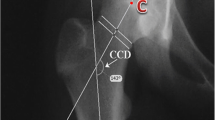Abstract
Introduction: Various modes of fixation are proposed for the treatment of slips of the capital femoral epiphysis (SCFE). We describe our experience with the use and removal of a new, cannulated titanium screw (Asnis III, Stryker®, Howmedica). Patients and methods: Single cannulated titanium screws had been inserted in 101 hips of 65 patients in the 3-year period from 2001 to 2003. These pins were used for in situ fixation of minor chronic slips in 41 patients and for prophylactic fixation on the contralateral side in patients with open physis in 60 patients. Results: The insertion of these screws was achieved without any real problem. The mean surgical time was 25 min (13–46 min). Problems came up when we started to remove the pins. Hardware retrieval was attempted in 27 patients with 43 pins. The mean surgical time for removal was double the average time of insertion with 51 min (26–107 min). The hexagonal Allen sockets proved to be too weak to overcome the necessary torque for loosening the pin from bone and applying the reverse-cutting-force, necessary to extract the pin. Eleven patients needed extensive chiselling. Two adolescents sustained a subtrochanteric fracture 5 and 7 weeks after hardware removal. Seven pins could not be totally removed. Conclusion: Due to the considerable disadvantages encountered in our series we conclude that Asnis III cannulated screws should be suspended from further use in SCFE.


Similar content being viewed by others
References
Baynham GC, Lucie RS, Cummings RJ (1991) Femoral neck fracture secondary to in situ pinning of slipped capital femoral epiphysis: a previously unreported complication. J Pediatr Orthop 11:187–190
Canale ST, Casillas M, Banta JV (1997) Displaced femoral neck fractures at the bone-screw interface after in situ fixation of slipped capital femoral epiphysis. J Pediatr Orthop 17:212–215
Carney BT, Birnbaum P, Minter C (2003) Slip progression after in situ single screw fixation for stable slipped capital femoral epiphysis. J Pediatr Orthop 23:584–589
Crandall DG, Gabriel KR, Akbarnia BA (1992) Second operation for slipped capital femoral epiphysis: pin removal. J Pediatr Orthop 12:434–437
Eulenberger J, Steinemann SG (1990) Removal torques of small screws of steel and titanium with different surfaces. Unfallchirurg 93:96–99
Gruber MA, Starkweather KD, Healy WA III, Haralabatos S (1996) Percutaneous screw removal in slipped upper femoral epiphysis. J Bone Joint Surg Br 78:137–139
Guzzanti V, Falciglia F, Stanitski CL (2004) Slipped capital femoral epiphysis in skeletally immature patients. J Bone Joint Surg Br 86:731–736
Jago ER, Hindley CJ, Jago RD (1998) The removal of metalwork in children. Injury 29:439–441
Karagkevrekis CB, Rahman H (2003) Subtrochanteric femoral fracture following removal of screw for slipped capital femoral epiphysis. Injury 34:320–321
Kenny P, Higgins T, Sedhom M, Dowling F, Moore DP, Fogarty EE (2003) Slipped upper femoral epiphysis. A retrospective, clinical and radiological study of fixation with a single screw. J Pediatr Orthop B 12:97–99
Kibiloski LJ, Doane RM, Karol LA, Haut RC, Loder RT (1994) Biomechanical analysis of single- versus double-screw fixation in slipped capital femoral epiphysis at physiological load levels. J Pediatr Orthop 14:627–630
Larsson S, Friberg S (1987) Complications at extraction of the ASIF epiphysiodesis screws. Acta Orthop Scand 58:483–484
Lee TK, Haynes RJ, Longo JA, Chu JR (1996) Pin removal in slipped capital femoral epiphysis: the unsuitability of titanium devices. J Pediatr Orthop 16:49–52
Nonweiler B, Hoffer M, Weinert C, Rosenfeld S (1996) Percutaneous in situ fixation of slipped capital femoral epiphysis using two threaded Steinmann pins. J Pediatr Orthop 16:56–60
Stambough JL, Davidson RS, Ellis RD, Gregg JR (1986) Slipped capital femoral epiphysis: an analysis of 80 patients as to pin placement and number. J Pediatr Orthop 6:265–273
Terheyden H, Muhlendyck C, Sprengel M, Ludwig K, Harle F (1999) Self-adapting washer system for lag screw fixation of mandibular fractures. Part II: In vitro mechanical characterization of 2.3 and 2.7 mm lag screw prototypes and in vivo removal torque after healing. J Craniomaxillofac Surg 27:243–251
Tokmakova KP, Stanton RP, Mason DE (2003) Factors influencing the development of osteonecrosis in patients treated for slipped capital femoral epiphysis. J Bone Joint Surg Am 85:798–801
Uglow MG, Clarke NM (2004) The management of slipped capital femoral epiphysis. J Bone Joint Surg Br 86:631–635
Vresilovic EJ, Spindler KP, Robertson WW, Davidson RS Jr., Drummond DS (1990) Failures of pin removal after in situ pinning of slipped capital femoral epiphyses: a comparison of different pin types. J Pediatr Orthop 10:764–768
Warner JG, Bramley D, Kay PR (1994) Failure of screw removal after fixation of slipped capital femoral epiphysis: the need for a specific screw design. J Bone Joint Surg Br 76:844–845
Author information
Authors and Affiliations
Corresponding author
Rights and permissions
About this article
Cite this article
Ilchmann, T., Parsch, K. Complications at screw removal in slipped capital femoral epiphysis treated by cannulated titanium screws. Arch Orthop Trauma Surg 126, 359–363 (2006). https://doi.org/10.1007/s00402-006-0126-5
Received:
Published:
Issue Date:
DOI: https://doi.org/10.1007/s00402-006-0126-5




